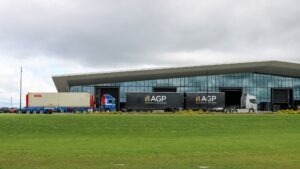From survival to strategy
Creating a business that runs without you

Step into almost any Kiwi workshop at 6 a.m. and you’ll find the owner already there, fixing yesterday’s problem before the team clocks in. They’re signing off orders, juggling suppliers, answering calls and putting out fires faster than they ignite.
By mid-morning they’ve handled a breakdown, approved a quote, covered for someone off sick, chased an overdue invoice… and by evening they’re back on email. Not by choice, but because if they don’t, no one else will.
David Altena is head of Growth & Partnerships at SmartSpace.ai and C0-Founder and Host of The Better SMB Podcast.

We call it leadership. In reality, it’s survival with a spreadsheet and it’s no wonder we’re producing 30% less than our OECD peers.
Here’s the uncomfortable truth: if your business grinds to a halt the moment you step away, you don’t own a business, you own a job with overheads. That’s no foundation for a high performing business, growth, or succession.
Rob is Director of the New Zealand Lean Academy. www.rob@nzla.net
Survival isn’t strategy
Contrast that with firms operating at a higher level of maturity. Leaders aren’t caught up in the day-to-day, they have clear business plans and measurable KPIs. They hold quarterly reviews where leaders coach instead of firefight.
They invest in systems to capture knowledge and create consistency and aren’t reliant on one person’s memory or availability.
Their systems are stronger than their heroes.
The markers of operational maturity
Operational maturity doesn’t come from a new machine or a fresh ERP licence. It comes from design and discipline, doing the boring things brilliantly:
Clear purpose and numbers: every employee knows the three metrics that matter most and how their work moves them.
Standard work before scale: processes are documented, taught and audited so improvements stick.
Regular rhythm of review: daily huddles, monthly scorecards, and quarterly business reviews reset priorities before problems compound.
Financial literacy at every level: leaders and teams understand the cost of waste, rework, and delay, not just the accountant.
Distributed leadership: owners lead through others, not around them. Coaching replaces control.
It’s not revolutionary. But it is transformational.
Case in point: Architectural Glass Products
 When we sat down with Dave Bunting, Managing Director at Architectural Glass Products (AGP) in Cambridge, his story cut straight to the heart of this shift from founder-dependence to system-dependence.
When we sat down with Dave Bunting, Managing Director at Architectural Glass Products (AGP) in Cambridge, his story cut straight to the heart of this shift from founder-dependence to system-dependence.
AGP is a double-glazing manufacturer supplying the APL network nationwide out of a facility you can spot from the Waikato Expressway. It’s one of the most advanced glass operations in the Southern Hemisphere. But the real advantage isn’t the kit; it’s the way they lead.
From day one, AGP made a deliberate choice not to hire from the glass industry. They backed their training mechanisms and culture. They recruited for humility, ownership, and learning agility; then taught the craft.
As the business scaled to its fourth line, the focus shifted even more towards bottom-up improvement; operators identifying issues, leaders removing roadblocks.
Leadership isn’t a title, it’s a system. AGP runs a flat structure with explicit decision rights. Anyone can challenge a direction with evidence, but the right person makes the call.
It’s not the most senior person but the person with the comparative advantage for that decision. Once the call’s made, everyone rows in the same direction. That builds momentum without the bottleneck of a single “hero”.
Their operational rhythm is deceptively simple:
Daily stand-ups: 15 minutes, max. If the KPI is green, move on. If it’s red, find the root cause, triage the fix and get back to work. No voodoo theories, no excuses. Just facts and follow-through.
Data before drama: start with observation and measurement (yes, sometimes the tool is still a clipboard, a stopwatch and a can-do attitude). Many gains came from tiny, targeted fixes; like a $100 audio alarm to prompt a changeover at the right moment.
Here’s the point: AGP’s excellence isn’t because it’s a Greenfield site or because they bought shinier machines than everyone else. Dave’s led older plants overseas to similarly high performance.
The differentiator is leadership discipline. Humility to be challenged, courage to delegate decision rights and the daily grind of review and improvement.
That maturity doesn’t just boost performance; it builds confidence for investment. Investors and owners can back systems with predictable outcomes. Teams stay because they’re growing. Customers stick because they can trust delivery. That’s how you turn operational maturity into a strategic moat.
From founder-centric to future-ready
This isn’t about letting go; it’s about stepping up.
When you mature your operations, you don’t lose control, you gain freedom. Freedom to innovate and focus on customers. Freedom to open new markets.
A founder-centric business relies on the energy of one person. A future-ready business relies on a system of people and that shift changes everything:
- You stop being the bottleneck and become the catalyst
- You stop reacting to problems and start designing performance
- You stop hiring followers and start growing leaders
That’s the real dividend of maturity. Not just higher profits, but the peace of mind that your business can thrive without you.
The freedom formula
 Every process you document, every system you build, every team member you empower is another step toward freedom.
Every process you document, every system you build, every team member you empower is another step toward freedom.
Freedom to think longer-term
Freedom to step back without everything collapsing
Freedom to innovate rather than imitate
That freedom makes your business investable. No one wants to buy your burnout. They want a system that performs, with or without the founder on the floor.
Investors back systems, not superheroes.
A 10-minute self-audit (to do this week)
- Rhythm: Do you have a daily 10–15 minute stand-up with clear red/green KPIs and immediate triage for reds?
- Visibility: Are the three most important numbers visible to everyone, and does each person know how they affect them?
- Decision rights: Who actually owns key decisions and do they have the comparative advantage to make them?
- Standard work: Is the “best known way” documented, taught and audited, or is it trapped in someone’s head?
- Freedom test: If you stepped away for 30 days, would performance hold?
Where you’ve scored a “no” ask yourself why and is your roadmap.
Your challenge
If you stepped away for 30 days, would your business run, or would it run aground?
The answer tells you everything about where you sit on the maturity curve.
Survival mode is a habit. Strategy is a choice.
Build a business that can run, scale and win without you. Because the real measure of leadership isn’t how much your business needs you. It’s how well it performs when you’re not there.
Make the shift from founder-centric to future-ready.
Want to hear what is sounds like in action? Listen to our interview with Dave Bunting on The Better SMB Podcast



